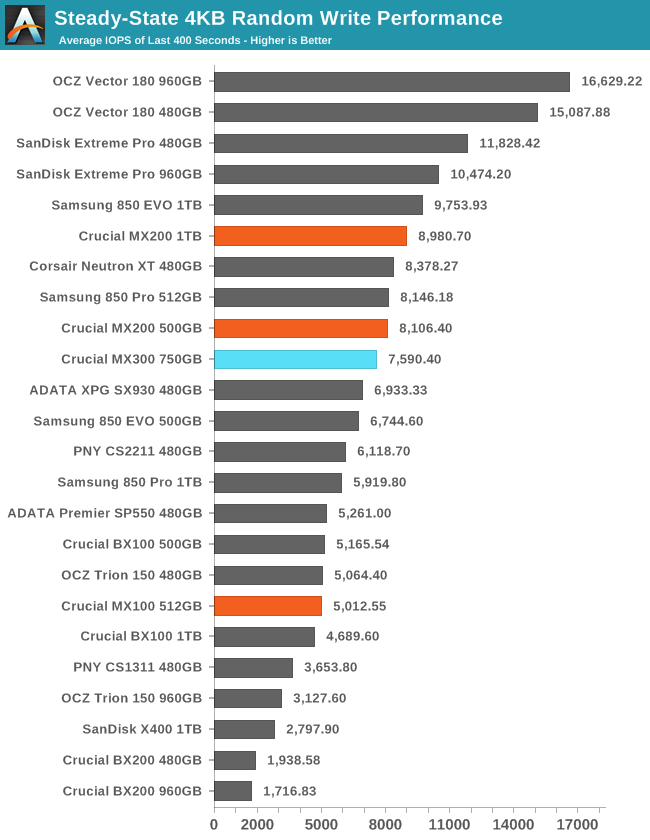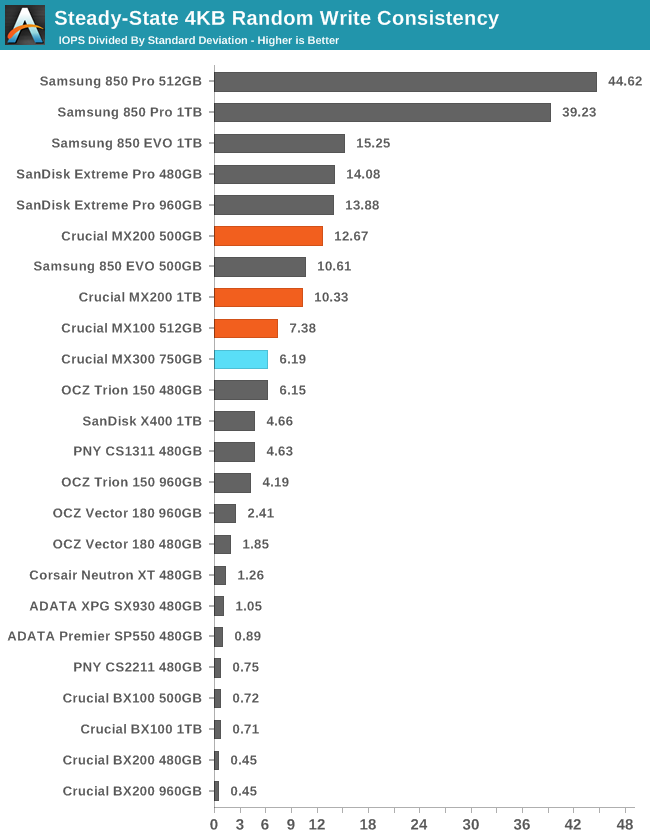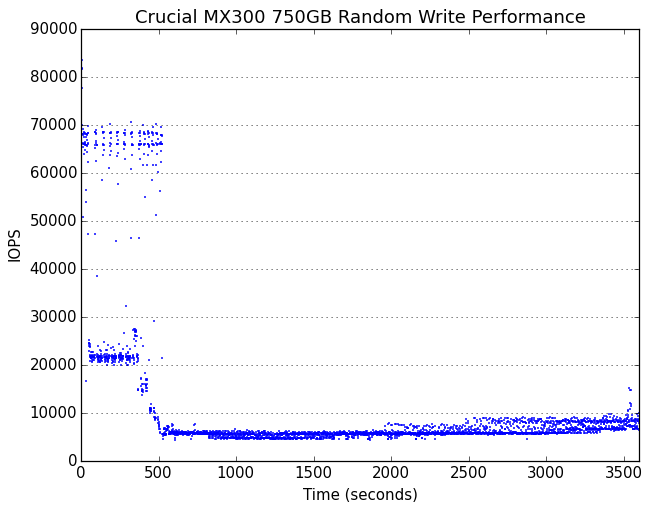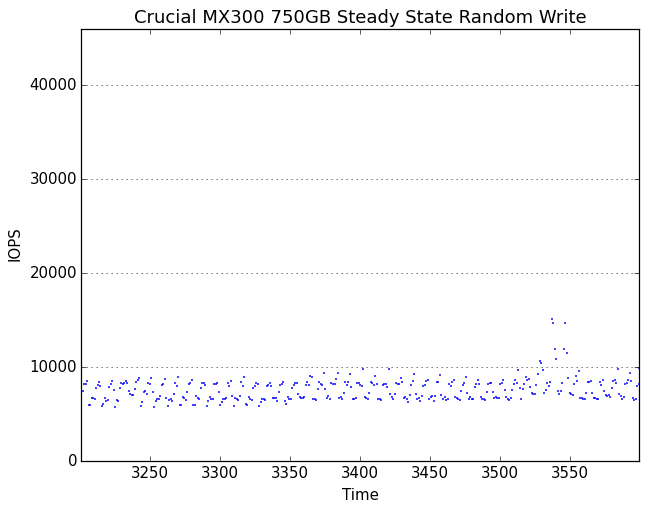The Crucial MX300 750GB SSD Review: Micron's 3D NAND Arrives
by Billy Tallis on June 14, 2016 9:00 AM ESTPerformance Consistency
Our performance consistency test explores the extent to which a drive can reliably sustain performance during a long-duration random write test. Specifications for consumer drives typically list peak performance numbers only attainable in ideal conditions. The performance in a worst-case scenario can be drastically different as over the course of a long test drives can run out of spare area, have to start performing garbage collection, and sometimes even reach power or thermal limits.
In addition to an overall decline in performance, a long test can show patterns in how performance varies on shorter timescales. Some drives will exhibit very little variance in performance from second to second, while others will show massive drops in performance during each garbage collection cycle but otherwise maintain good performance, and others show constantly wide variance. If a drive periodically slows to hard drive levels of performance, it may feel slow to use even if its overall average performance is very high.
To maximally stress the drive's controller and force it to perform garbage collection and wear leveling, this test conducts 4kB random writes with a queue depth of 32. The drive is filled before the start of the test, and the test duration is one hour. Any spare area will be exhausted early in the test and by the end of the hour even the largest drives with the most overprovisioning will have reached a steady state. We use the last 400 seconds of the test to score the drive both on steady-state average writes per second and on its performance divided by the standard deviation.

The MX300's steady state random write performance is below the MX200 but stays slightly ahead of the 850 EVO and well ahead of any planar TLC drive.

The MX300 earns a consistency score that is below the MX200 but about average, and certainly high enough for ordinary consumer workloads.
 |
|||||||||
| Default | |||||||||
| 25% Over-Provisioning | |||||||||
The MX300 lasts for over eight minutes before the SLC cache and spare area are completely exhausted, but during that phase it alternates between operating at about 22k IOPS and 65-70k IOPS. During the steady state phase there is gradual improvement in performance along with an increase in variability.
 |
|||||||||
| Default | |||||||||
| 25% Over-Provisioning | |||||||||
The steady state random write performance of the MX300 varies periodically between about 6k IOPS to 10k IOPS, with no outliers of slow performance. With extra overprovisioning performance is substantially higher and consistency is a bit better.










85 Comments
View All Comments
Gondalf - Wednesday, June 15, 2016 - link
Good point. The real story the have not even read the article, or maybe there is a lot of marketing guys at work here.After all Samsung has shipped for two years 3D SSD drivers in nearly money loss cause the low yields of their manufacturing process on a 3D structure.
icrf - Tuesday, June 14, 2016 - link
What is the expected performance of the 3D MLC NVMe SSD, or is that too many variables different to tell from here? I'm curious if the charge trap/floating gate decision affected performance.jabber - Tuesday, June 14, 2016 - link
I'm taking it that Crucial have given up on SSD R&D? After all each Crucial SSD post BX100 (what a great SSD) just gets slower than the previous.JoeyJoJo123 - Tuesday, June 14, 2016 - link
If Crucial has "given up" then what does that speak for Toshiba and other manufacturers that STILL haven't done 3D stacked MLC NAND?Samsung led the innovation 2 years ago and now their first competitor just showed up.
vladx - Tuesday, June 14, 2016 - link
Sandisk X400 seems to be the king of budget SSDs, paying 80USD more for 850 EVO is definitely not worth it imo.Meteor2 - Tuesday, June 14, 2016 - link
Can't dispute that.Lolimaster - Saturday, June 18, 2016 - link
They're not.Unless you move tons of data per day with more than 1 pci-e nvme drive there's no difference between sata and pcie ssd's. PCie ssd uses more power and produces more heat.
Communism - Tuesday, June 14, 2016 - link
With the advent of PCIE 3.0 X4 NAND drives a while ago, the whole SATAIII segment of SSDs are essentially obsolete. The lack of significant competition in the PCIE3.0 X4 NAND drives bringing down prices quickly is disconcerting.The only COGS difference between PCIE3.0 X4 NAND drives and SATAIII drives is the controller, which doesn't actually cost much at all.
Buying into SATAIII SSDs at this point in time simply is a bad idea comparatively.
TheinsanegamerN - Tuesday, June 14, 2016 - link
Sara is hardly obsolete. Pcie m2 drives still only hit 512gb vs the 2tb sata drives, still run hotter, and don't offer much but a faster boot time. Day to day performance between sata and pice is nil unless you are moving hundreds of gigs of data per day onto/off of the drive.Until m.2 is cheaper, cooler, and the same capacity as sata, sata isn't going anywhere.
vladx - Tuesday, June 14, 2016 - link
Actually, NVMe drives boot slower because of additional drivers needed to be loaded.